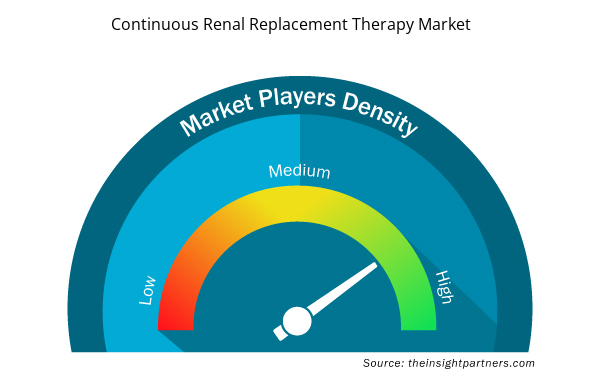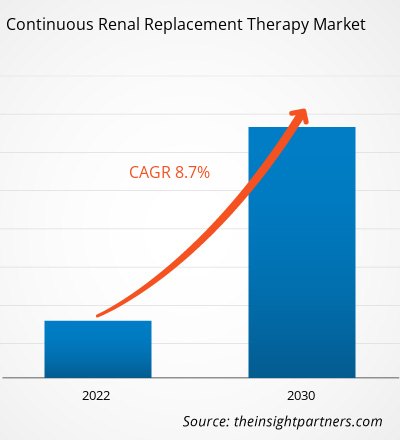[研究报告] 连续性肾脏替代治疗市场规模预计将从 2022 年的 14.2 亿美元增长到 2030 年的 27.5 亿美元。预计 2022 年至 2030 年期间市场复合年增长率为 8.7%。
市场洞察和分析师观点:
本报告包括当前持续性肾脏替代治疗市场趋势及其在预测期内可预见的影响所带来的增长前景。
持续性肾脏替代疗法 (CRRT) 是一种挽救生命的干预措施,适用于患有严重急性肾损伤 (AKI)、液体超负荷和尿毒症并伴有潜在致命代谢异常的患者。儿科 CRRT 设备需求增加以及导致肾脏疾病的慢性病患病率高等因素推动了持续性肾脏替代疗法市场的增长。然而,发生重大不良肾脏事件 (MAKE) 的可能性很大,这限制了市场的增长。
市场驱动因素:
慢性病发病率高,导致肾脏疾病
全球每 10 人中就有 1 人患有慢性肾病(CKD),这是一种常见且危及生命的疾病。2015 年至 2019 年,糖尿病和高血压是导致肾衰竭的两个主要原因,占总衰竭病例的 75%。根据美国国家肾脏基金会 2020 年发布的估计数据,在美国,20 岁以上的糖尿病患者中约有 30% 在其一生中面临患上 CKD 的风险。此外,2020 年这种疾病造成的死亡人数超过了前列腺癌或乳腺癌,是一种未被充分认识的紧急健康障碍。三分之一的美国成年人(即约 8000 万人)面临 CKD 的风险,CKD 现在已被确定为 AKI 的明确危险因素。肾小球滤过率 (GFR) 降低和蛋白尿增加与 AKI 密切相关。
根据美国国立卫生研究院的数据,发达国家的急性肾损伤发病率正在上升。预计住院患者的急性肾损伤发病率将达到 15%,重症患者的发病率更高,为 60%。全球住院患者的急性肾损伤发病率为 0.7% 至 31%;重症监护病房 (ICU) 患者的发病率超过 50%。3% 至 13% 的急性肾损伤患者需要接受 RRT,其中 40% 的患者估计需要接受 CRRT 超过 90 天。因此,导致肾脏疾病的慢性病高发病率推动了肾脏替代治疗市场的持续增长。
CRRT 的主要不良反应包括低血压、心动过速和其他心律失常,这些可能会对患者的病情产生不利影响或阻碍其康复。此外,CRRT 回路可能会促进微量营养素、微量元素和/或治疗药物的更快清除,这可能导致血液和组织中浓度低或不规则,从而引起不良反应和/或治疗效果丧失。因此,不良反应限制了连续性肾脏替代治疗市场。
定制此报告以满足您的需求
您可以免费定制任何报告,包括本报告的部分内容、国家级分析、Excel 数据包,以及为初创企业和大学提供优惠和折扣
- 获取此报告的关键市场趋势。这个免费样品将包括数据分析,从市场趋势到估计和预测。
报告细分和范围:
持续性肾脏替代治疗市场分析已从以下几个方面进行考虑:产品、方式和最终用户。
节段分析:
持续性肾脏替代治疗市场按产品细分为透析液和置换液、一次性用品、血路套件和管路、CRRT 系统和血液过滤器。CRRT 系统部分在 2022 年占据了最大的市场份额。预计血液过滤器部分将在 2022-2030 年期间实现最高的复合年增长率。
根据治疗方式,持续性肾脏替代治疗市场分为持续性静脉-静脉血液滤过 (CVVH)、持续性静脉-静脉血液透析滤过 (CVVHDF)、持续性静脉-静脉血液透析 (CVVHD) 和慢速持续超滤 (SCUF)。持续性静脉-静脉血液滤过 (CVVH) 细分市场在 2022 年占据了最大的市场份额。持续性静脉-静脉血液透析滤过 (CVVHDF) 细分市场的复合年增长率预计在 2022-2030 年期间最高。
根据最终用户,持续性肾脏替代治疗市场分为医院、门诊护理中心、家庭护理和其他。2022 年,医院部门占据了持续性肾脏替代治疗市场份额的主导地位。然而,预计家庭监测部门在 2022-2030 年期间的复合年增长率最高。
区域分析:
连续性肾脏替代治疗市场报告的范围涵盖北美(美国、加拿大和墨西哥)、欧洲(西班牙、英国、德国、法国、意大利和欧洲其他地区)、亚太地区(韩国、中国、印度、日本、澳大利亚和亚太其他地区)、中东和非洲(南非、沙特阿拉伯、阿联酋和中东和非洲其他地区)以及南美洲和中美洲(巴西、阿根廷和南美洲和中美洲其他地区)。
就收入而言,2022 年,北美占据了连续性肾脏替代治疗市场份额的主导地位。预计亚太地区市场将在 2022-2030 年期间实现最高复合年增长率。随着医疗基础设施的改善和创新 CRRT 技术的采用,亚太地区的连续性肾脏替代治疗市场正在增长,这两者都可能与医疗支出的增加有关。此外,市场参与者为扩大其在亚太地区的影响力而采取的战略举措,例如与当地医疗保健提供商的合作,有利于该地区的市场增长。
连续性肾脏替代治疗市场区域洞察
Insight Partners 的分析师已详尽解释了预测期内影响持续性肾脏替代疗法市场的区域趋势和因素。本节还讨论了北美、欧洲、亚太地区、中东和非洲以及南美和中美洲的持续性肾脏替代疗法市场细分和地理位置。

- 获取连续肾脏替代治疗市场的区域特定数据
连续性肾脏替代治疗市场报告范围
| 报告属性 | 细节 |
|---|---|
| 2022 年市场规模 | 14.2亿美元 |
| 2030 年的市场规模 | 27.5亿美元 |
| 全球复合年增长率(2022 - 2030 年) | 8.7% |
| 史料 | 2020-2022 |
| 预测期 | 2022-2030 |
| 涵盖的领域 | 按产品
|
| 覆盖地区和国家 | 北美
|
| 市场领导者和主要公司简介 |
|
连续性肾脏替代治疗市场参与者密度:了解其对业务动态的影响
持续性肾脏替代治疗市场正在快速增长,这得益于终端用户需求的不断增长,而这些需求又源于消费者偏好的不断变化、技术进步以及对产品优势的认识不断提高等因素。随着需求的增加,企业正在扩大其产品范围,进行创新以满足消费者的需求,并利用新兴趋势,从而进一步推动市场增长。
市场参与者密度是指在特定市场或行业内运营的企业或公司的分布情况。它表明在给定市场空间中,相对于其规模或总市场价值,有多少竞争对手(市场参与者)存在。
在连续性肾脏替代治疗市场运营的主要公司有:
- 百特国际公司
- 旭化成
- 费森尤斯医疗保健
- 梅迪卡公司
- 美敦力公司
免责声明:上面列出的公司没有按照任何特定顺序排列。

- 了解持续肾脏替代治疗市场的主要参与者概况
竞争格局和重点公司:
持续性肾脏替代疗法市场报告重点关注市场中的知名企业,例如 Baxter International Inc、Asahi Kasei、Fresenius Medical Care、Medica SpA、Medtronic Plc、B. Braun、Nikkiso Co Ltd、Toray Medical Co Ltd、Infomed SA 和 Quanta Dialysis Technologies Inc。持续性肾脏替代疗法市场预测可以帮助利益相关者规划其增长战略。这些公司专注于推出新技术、升级现有产品并扩展业务以满足全球不断增长的消费者需求。
- 2022 年 4 月,美国食品药品管理局 (FDA) 为 Baxter International Inc. 的 ST Set 颁发了 510(k) 许可,用于持续性肾脏替代疗法 (CRRT)。ST Set 是一种预连接的一次性体外回路,可通过半透膜提供血液净化,可与 PrisMax 或 Prismaflex 控制单元(监视器)一起使用。
- 2022 年 3 月,领先的肾脏、血管和外科医疗产品制造商和供应商 Nipro Medical Corporation (Nipro) 宣布在美国推出 SURDIAL DX 血液透析系统。SURDIAL DX 是一款最先进的血液透析系统,旨在为患者和临床医生创造最佳的透析治疗体验。该产品在日本制造,基于 Nipro 母公司 Nipro Corporation 在肾脏设备创新方面超过 35 年的专业知识。
- 历史分析(2 年)、基准年、预测(7 年)及复合年增长率
- PEST 和 SWOT 分析
- 市场规模价值/数量 - 全球、区域、国家
- 行业和竞争格局
- Excel 数据集


- Wind Turbine Composites Market
- Mail Order Pharmacy Market
- Underwater Connector Market
- Broth Market
- MEMS Foundry Market
- Trade Promotion Management Software Market
- Bioremediation Technology and Services Market
- Electronic Signature Software Market
- Visualization and 3D Rendering Software Market
- Procedure Trays Market

Report Coverage
Revenue forecast, Company Analysis, Industry landscape, Growth factors, and Trends

Segment Covered
This text is related
to segments covered.

Regional Scope
North America, Europe, Asia Pacific, Middle East & Africa, South & Central America

Country Scope
This text is related
to country scope.
常见问题
Continuous renal replacement therapy is an available renal replacement method that includes intermittent hemodialysis and peritoneal dialysis to provide renal support for critically ill patients with acute kidney injury, mainly patients who are hemodynamically unstable. It is intended to be applied for 24 hours or longer through continuous, slower dialysis. CRRT is performed through pump-driven venovenous extracorporeal circuits and acts as renal support through blood purification to allow solute and fluid homeostasis.
The continuous renal replacement therapy market majorly consists of players such as Baxter International Inc, Asahi Kasei, Fresenius Medical Care, Medica S.p.A., Medtronic Plc, B. Braun, Nikkiso Co Ltd, Toray Medical Co Ltd, Infomed SA, and Quanta Dialysis Technologies Inc.
US holds the largest market share in continuous renal replacement therapy market According to the Centers for Disease Control and Prevention in 2021, ~785,000 people in the US were living with end-stage kidney disease also known as end-stage renal disease; 71% out of these were undergoing dialysis while 29% had undergone kidney transplant procedures. As of 2020, there were nearly 7,500 dialysis clinics in the US. The increasing adoption of unhealthy food habits is one of the most prominent risk factor for numerous lifestyle-related disorders such as hypertension, diabetes, and kidney dysfunction.
The factors that are driving the growth of the market are the increased demand for pediatric CRRT devices and the high prevalence of chronic diseases leading to kidney diseases.
The continuous renal replacement therapy market, based on product, is segmented into dialysates and replacement fluids, disposables, bloodline sets and tubes, CRRT systems, and hemofilters. The CRRT systems segment held the largest share of the market in 2022.
The continuous renal replacement therapy market, based on modality, is continuous venovenous hemofiltration (CVVH), continuous venovenous hemodiafiltration (CVVHDF), continuous venovenous hemodialysis (CVVHD), and slow continuous ultrafiltration (SCUF). The continuous venovenous hemofiltration (CVVH) segment held the largest share of the market in 2022; however, the continuous venovenous hemodiafiltration (CVVHDF) segment is likely to register the highest CAGR.
Asia Pacific is expected to be the fastest-growing region in the continuous renal replacement therapy market. Improving healthcare infrastructure with rising expenditure and the adoption of innovative CRRT technologies bolster the continuous renal replacement therapy market size in Asia Pacific. Additionally, strategic initiatives by the market players to expand their presence in this region, including collaborations with local healthcare providers, favor the market growth in the region.
The continuous renal replacement therapy market, based on end user, is segmented into hospitals, ambulatory care centers, home care, and others. In 2022, the hospitals segment dominated the continuous renal replacement therapy market share. The home monitoring segment is expected to register the highest CAGR during 2022–2030.
Trends and growth analysis reports related to Life Sciences : READ MORE..
The List of Companies - Continuous Renal Replacement Therapy Market
- Baxter International Inc
- Asahi Kasei
- Fresenius Medical Care
- Medica S.p.A.
- Medtronic Plc
- B. Braun
- Nikkiso Co Ltd
- Toray Medical Co Ltd
- Infomed SA
- Quanta Dialysis Technologies Inc
The Insight Partners performs research in 4 major stages: Data Collection & Secondary Research, Primary Research, Data Analysis and Data Triangulation & Final Review.
- Data Collection and Secondary Research:
As a market research and consulting firm operating from a decade, we have published and advised several client across the globe. First step for any study will start with an assessment of currently available data and insights from existing reports. Further, historical and current market information is collected from Investor Presentations, Annual Reports, SEC Filings, etc., and other information related to company’s performance and market positioning are gathered from Paid Databases (Factiva, Hoovers, and Reuters) and various other publications available in public domain.
Several associations trade associates, technical forums, institutes, societies and organization are accessed to gain technical as well as market related insights through their publications such as research papers, blogs and press releases related to the studies are referred to get cues about the market. Further, white papers, journals, magazines, and other news articles published in last 3 years are scrutinized and analyzed to understand the current market trends.
- Primary Research:
The primarily interview analysis comprise of data obtained from industry participants interview and answers to survey questions gathered by in-house primary team.
For primary research, interviews are conducted with industry experts/CEOs/Marketing Managers/VPs/Subject Matter Experts from both demand and supply side to get a 360-degree view of the market. The primary team conducts several interviews based on the complexity of the markets to understand the various market trends and dynamics which makes research more credible and precise.
A typical research interview fulfils the following functions:
- Provides first-hand information on the market size, market trends, growth trends, competitive landscape, and outlook
- Validates and strengthens in-house secondary research findings
- Develops the analysis team’s expertise and market understanding
Primary research involves email interactions and telephone interviews for each market, category, segment, and sub-segment across geographies. The participants who typically take part in such a process include, but are not limited to:
- Industry participants: VPs, business development managers, market intelligence managers and national sales managers
- Outside experts: Valuation experts, research analysts and key opinion leaders specializing in the electronics and semiconductor industry.
Below is the breakup of our primary respondents by company, designation, and region:

Once we receive the confirmation from primary research sources or primary respondents, we finalize the base year market estimation and forecast the data as per the macroeconomic and microeconomic factors assessed during data collection.
- Data Analysis:
Once data is validated through both secondary as well as primary respondents, we finalize the market estimations by hypothesis formulation and factor analysis at regional and country level.
- Macro-Economic Factor Analysis:
We analyse macroeconomic indicators such the gross domestic product (GDP), increase in the demand for goods and services across industries, technological advancement, regional economic growth, governmental policies, the influence of COVID-19, PEST analysis, and other aspects. This analysis aids in setting benchmarks for various nations/regions and approximating market splits. Additionally, the general trend of the aforementioned components aid in determining the market's development possibilities.
- Country Level Data:
Various factors that are especially aligned to the country are taken into account to determine the market size for a certain area and country, including the presence of vendors, such as headquarters and offices, the country's GDP, demand patterns, and industry growth. To comprehend the market dynamics for the nation, a number of growth variables, inhibitors, application areas, and current market trends are researched. The aforementioned elements aid in determining the country's overall market's growth potential.
- Company Profile:
The “Table of Contents” is formulated by listing and analyzing more than 25 - 30 companies operating in the market ecosystem across geographies. However, we profile only 10 companies as a standard practice in our syndicate reports. These 10 companies comprise leading, emerging, and regional players. Nonetheless, our analysis is not restricted to the 10 listed companies, we also analyze other companies present in the market to develop a holistic view and understand the prevailing trends. The “Company Profiles” section in the report covers key facts, business description, products & services, financial information, SWOT analysis, and key developments. The financial information presented is extracted from the annual reports and official documents of the publicly listed companies. Upon collecting the information for the sections of respective companies, we verify them via various primary sources and then compile the data in respective company profiles. The company level information helps us in deriving the base number as well as in forecasting the market size.
- Developing Base Number:
Aggregation of sales statistics (2020-2022) and macro-economic factor, and other secondary and primary research insights are utilized to arrive at base number and related market shares for 2022. The data gaps are identified in this step and relevant market data is analyzed, collected from paid primary interviews or databases. On finalizing the base year market size, forecasts are developed on the basis of macro-economic, industry and market growth factors and company level analysis.
- Data Triangulation and Final Review:
The market findings and base year market size calculations are validated from supply as well as demand side. Demand side validations are based on macro-economic factor analysis and benchmarks for respective regions and countries. In case of supply side validations, revenues of major companies are estimated (in case not available) based on industry benchmark, approximate number of employees, product portfolio, and primary interviews revenues are gathered. Further revenue from target product/service segment is assessed to avoid overshooting of market statistics. In case of heavy deviations between supply and demand side values, all thes steps are repeated to achieve synchronization.
We follow an iterative model, wherein we share our research findings with Subject Matter Experts (SME’s) and Key Opinion Leaders (KOLs) until consensus view of the market is not formulated – this model negates any drastic deviation in the opinions of experts. Only validated and universally acceptable research findings are quoted in our reports.
We have important check points that we use to validate our research findings – which we call – data triangulation, where we validate the information, we generate from secondary sources with primary interviews and then we re-validate with our internal data bases and Subject matter experts. This comprehensive model enables us to deliver high quality, reliable data in shortest possible time.


 获取此报告的免费样本
获取此报告的免费样本